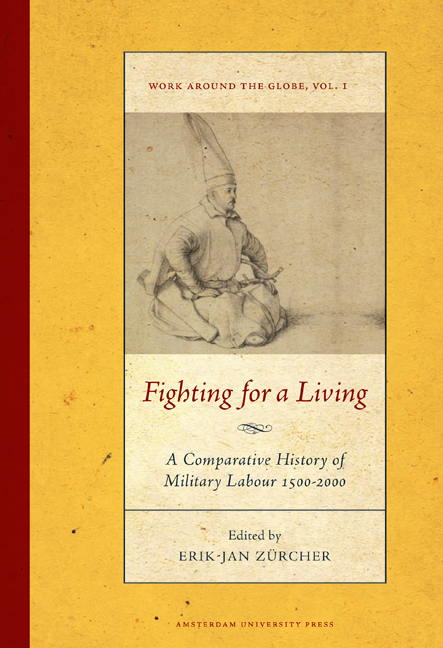Book contents
- Frontmatter
- Dedication
- Contents
- Preface
- Introduction: Understanding Changes in Military Recruitment and Employment Worldwide
- Military Labor in China, c. 1500
- From the Mamluks to the Mansabdars: A Social History of Military Service in South Asia, c. 1500 to c. 1650
- On the Ottoman Janissaries (Fourteenth-nineteenth Centuries)
- Soldiers in Western Europe, c. 1500-17901
- The Scottish Mercenary as a Migrant Labourer in Europe, 1550-1650
- Change and Continuity in Mercenary Armies: Central Europe, 1650-1750
- Peasants Fighting for a Living in Early Modern North India
- “True to Their Salt”: Mechanisms for Recruiting and Managing Military Labour in the Army of the East India Company During the Carnatic Wars in India
- “The Scum of Every County, the Refuse of Mankind”: Recruiting the British Army in the Eighteenth Century
- Mobilization of Warrior Populations in the Ottoman Context, 1750-1850
- Military Employment in Qing Dynasty China
- Military Service and the Russian Social Order, 1649-1861
- The French army, 1789-1914: Volunteers, Pressed Soldiers, and Conscripts
- The Dutch Army in Transition: From All-volunteer Force to Cadre-militia Army, 1795-1830
- The Draft and Draftees in Italy, 1861-1914
- Nation-building, War Experiences, and European Models: The Rejection of Conscription in Britain
- Mobilizing Military Labor in the Age of Total War: Ottoman Conscription Before and During the Great War
- Soldiering as Work: The All-volunteer Force in the United States
- Private Contractors in War From the 1990s to the Present: A Review Essay
- Collective Bibliography
- Notes on Contributors
Mobilizing Military Labor in the Age of Total War: Ottoman Conscription Before and During the Great War
Published online by Cambridge University Press: 12 December 2020
- Frontmatter
- Dedication
- Contents
- Preface
- Introduction: Understanding Changes in Military Recruitment and Employment Worldwide
- Military Labor in China, c. 1500
- From the Mamluks to the Mansabdars: A Social History of Military Service in South Asia, c. 1500 to c. 1650
- On the Ottoman Janissaries (Fourteenth-nineteenth Centuries)
- Soldiers in Western Europe, c. 1500-17901
- The Scottish Mercenary as a Migrant Labourer in Europe, 1550-1650
- Change and Continuity in Mercenary Armies: Central Europe, 1650-1750
- Peasants Fighting for a Living in Early Modern North India
- “True to Their Salt”: Mechanisms for Recruiting and Managing Military Labour in the Army of the East India Company During the Carnatic Wars in India
- “The Scum of Every County, the Refuse of Mankind”: Recruiting the British Army in the Eighteenth Century
- Mobilization of Warrior Populations in the Ottoman Context, 1750-1850
- Military Employment in Qing Dynasty China
- Military Service and the Russian Social Order, 1649-1861
- The French army, 1789-1914: Volunteers, Pressed Soldiers, and Conscripts
- The Dutch Army in Transition: From All-volunteer Force to Cadre-militia Army, 1795-1830
- The Draft and Draftees in Italy, 1861-1914
- Nation-building, War Experiences, and European Models: The Rejection of Conscription in Britain
- Mobilizing Military Labor in the Age of Total War: Ottoman Conscription Before and During the Great War
- Soldiering as Work: The All-volunteer Force in the United States
- Private Contractors in War From the 1990s to the Present: A Review Essay
- Collective Bibliography
- Notes on Contributors
Summary
As warfare became more industrialized and total from the mid-nineteenth century onward, conscript labor became increasingly necessary to meet the manpower needs of modern mass armies. As a multifront and prolonged war of attrition, the Great War represents the apogee of this process. Military employment in the form of obligatory service, required of every male citizen as a patriotic duty, also defined a new interaction (both inclusive and exclusive) between the state and society, providing the centralizing state with a new mechanism of control at the local level. As a result, conscription was on the agenda not only of nation-states, but also of multiethnic empires, including the Ottoman Empire. This chapter deals with the Ottoman experience of conscription. After discussing Ottoman conscription from its beginnings in the nineteenth century, it focuses on its application during the Great War. Rather than presenting a thorough description of Ottoman conscription, the chapter explores its major characteristics and peculiarities. While basic categories of military labor were similar, the practice unfolded in different ways in different settings. Therefore, emphasizing “the Ottoman difference” is as important as underlining the similarities with other cases. Besides providing a critical analysis of Ottoman conscription, this chapter also aims to shed light on the Ottoman experience in order to bring it into a comparative perspective within the global history of military recruitment.
The evolution of Ottoman conscription
The French Revolution's levée en masse was enacted in 1793 to confront the threat of a multifront war with foreign powers and of rebellions at home by summoning all able-bodied men to defend the “nation”. The levy was regarded as an action that would put into practice Rousseau's prescription in the social contract that “every citizen should be a soldier by duty, not by trade”. Whereas the French revolutionary mass levy was an ad hoc measure, conscription acquired a systematic form in the age of Napoleon. But it was the mid-nineteenth-century Prussian model that gave the system a more established obligatory character and formed a military structure drafting large numbers of men in an efficient way. Conscription not only increased the efficiency of armies in the age of industrialized warfare, but also, and perhaps more importantly, formed new relations between state and society.
- Type
- Chapter
- Information
- Fighting for a LivingA Comparative Study of Military Labour 1500–2000, pp. 547 - 580Publisher: Amsterdam University PressPrint publication year: 2013



